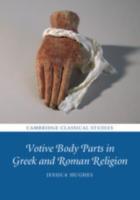
CUP (2017) h/b 219pp £75 (ISBN 9781107157835)
This excellent book will take the reader on a thoughtful perusal of four case studies, each designed to ‘track how and why the anatomical votive cult developed and spread’ while also considering their varied meanings.
In Chapter 1 H. begins by challenging the general assumption that anatomical votives simply indicate the afflicted part of the body and that the dedicant was either requesting healing or giving thanks for healing. H. tracks the scholarship associated with anatomical votives; anyone wishing to delve deeper will find the extremely detailed bibliography gives them all they need. H. explains that as well as considering ancient understandings of illnesses and healing, the book aims to develop Pazzini’s 1935 triangulation of votives, punishment and expiation; in addition, she seeks to force readers to recognise the shocking quality of these ‘dismembered’ bodies. Votive figurines from Neapolis in Sardinia remind us that there are alternative ways of drawing attention to a sick body part; therefore, one of the key questions considers why ancient cultures used the fragmented form of anatomical votives.
Chapter 2 considers the first case study; ‘Fragmentation as Metaphor’ considers the anatomical votives of Classical Greece. H. focuses on the Asklepieia of Corinth and Athens, and a detailed discussion of the votives is supported by black and white pictures of excellent clarity. H. reviews the range of body parts from the sites, contextualising them within other texts and images that display a fascination for the relationship between the whole body and its parts, such as Empedocles’ On Nature, the Doryphoros by Polykleitos and the vase of the Foundry Painter, with its depiction of pieces of statue. H. also notes the use of the divided body in political metaphor, most famously in Plato’s Timaeus. She argues that the fragmentation of the anatomical votives is a metaphorical representation of the body in illness and pain; punitive illness inflicted by a deity leads to fragmentation, whilst healing is a process of reintegration. To support this H. makes links to Thucydides’ description of the Athenian plague, as well the stories of dismemberment found in the myths of Pentheus and Actaeon. This argument is both persuasive and fascinating.
Chapter 3 moves to Republican Italy, where the main difference is to be seen in votives of internal organs. Intriguingly, Gravisca in south Etruria was one of a small group of sanctuaries that contain exclusively ‘female’ offerings, including a high number of uteri. H. notes that great variation in the uteri votives and pragmatically considers that this is surely due to artistic uncertainty about what the womb looked like. In Tessennano, near Canino, the distinctively ‘male’ characteristic of the deposits is further enlivened by unusual polyvisceral representations, where the trachea resembles a snake; H. suggests that they may express fears about animals living within the body, as well as a belief in an animated interior that could to some extent behave independently of its ‘owner.’ The presence of viscera in the anatomical votives raises the intriguing question about the inspiration for these representations; scholarly consensus says they were based on ‘opportune’ sightings of animal sacrifices and the practice of haruspicy. If this is so, then the votives were linked to a practice which saw anomalies and variations as evidence of divine-mortal communication. Given that the Greeks had equal opportunities to view viscera, their absence in Greek votives is probably connected to a feeling of disgust with the interior of the body.
Chapter 4 explores anatomical votives in Roman Gaul; the practice of dedicating anatomical votives was introduced by the Romans during the conquest of the province. The most numerous body parts found at the sanctuary of Dea Sequana at the source of the Seine are models of heads; H. notes that writers such as Diodorus Siculus and Strabo commented with disgust on the Pre-Roman Gallic practice of suspending the heads of their enemies from their horses’ necks, and it could perhaps be a process of ‘hybridisation’ whereby the Roman and pre-Roman traditions collide, producing a new way of making the body visible.
Chapter 5 is perhaps the most intriguing case study, as it considers the Lydian and Phrygian ‘Propitiatory Stelae’ of the second-third centuries AD, which give us the opportunity to investigate the anatomical depictions attached to long personal narratives. Given the mysterious nature of most votives, here there are clearly defined links between transgression, divine punishment, and appropriate expiation. The human body, like the sacrificial animal body, is presented as a medium through which the gods might express their displeasure. Further excellent illustrations support this chapter, which covers the concepts of divine omniscience, and the danger posed to other members of the family or community by transgressive acts.
This book would enhance the bookshelf of classicist and medical historian alike, and whilst the language is scholarly, it is not intimidating. H. does not make assumptions about prior knowledge, and therefore the book is accessible to a wider readership. It is to be warmly recommended.
Cath Milnes
